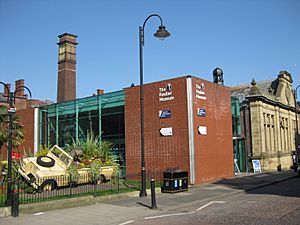Fusilier Museum facts for kids

The Fusilier Museum main entrance
|
|
| Lua error in Module:Location_map at line 420: attempt to index field 'wikibase' (a nil value). | |
| Established | 2009 |
|---|---|
| Location | Moss Street, Bury |
| Type | War museum |
| Public transit access | Bury Interchange |
The Fusilier Museum is a special place in Bury, Greater Manchester, England. It's like a time capsule, holding amazing collections of uniforms, medals, and other cool items from the Lancashire Fusiliers. This museum helps us remember the brave soldiers of this famous army regiment.
Contents
A Look Back: The Museum's Journey
The Fusilier Museum started its journey in a different spot. It was first located at the Wellington Barracks on Bolton Road. In 2009, the museum moved to its current home. This new building used to be the Bury Arts and Crafts Centre. It had been open for 110 years before closing in 2004.
Official Opening and Regiment Changes
The new museum officially opened on September 25, 2009. The Duke of Kent was there for the special event. The Lancashire Fusiliers Regiment itself stopped existing in 1968. It joined with three other regiments to form the Royal Regiment of Fusiliers. Because of this, the Fusilier Museum is part of a larger family. There are other Fusilier museums in places like Alnwick Castle, Warwick, and the Tower of London.
The Museum Building: A Historic Design
The building where the museum is now located has a long history. It was first designed as a Technical School for the Bury Borough Council. A local architect named Joshua Cartwright created the plans. He used a style called Neo-Renaissance, which looks back to old Roman and Greek designs. The building was finished in 1893.
Special Details of the Building
The front of the building still has the words "Technical School" carved into it. It also has a cool frieze, which is a long band of decoration. This frieze has five panels, each with five sculpted figures. These figures represent different skills taught at the school. You can see symbols for mathematics, science, engineering, printing, pottery, literature, and music. The artists who sculpted these figures were John Jarvis Millson and J.R. Whittick. In the 1940s, the school changed. It became the School of Arts and Crafts, and later the Arts and Crafts Centre. Today, it is a Grade II listed building, meaning it's protected for its historical importance.
What You Can See: The Museum's Collection
The museum is home to the amazing collection of the Lancashire Fusiliers. It tells the story of over 300 years of the regiment's history. You can learn about the soldiers and their experiences. Right next to the museum, there's a special place called the Gallipoli Garden. There is also the Lancashire Fusiliers War Memorial, which is a very important monument.
Brave Heroes: Victoria Crosses at the Museum
The museum proudly displays several Victoria Crosses. This is the highest award for bravery in the British military. It is given for incredible acts of courage in battle. The museum holds the Victoria Crosses awarded to these brave members of the regiment during the First World War:
- Sergeant Harold John Colley, 10th Battalion, Lancashire Fusiliers
- Lance Sergeant William Kenealy, 1st Battalion, Lancashire Fusiliers
- Private John Lynn, 2nd Battalion, Lancashire Fusiliers
- Second Lieutenant John Schofield, 5th Battalion, Lancashire Fusiliers
- Sergeant Frank Edward Stubbs, 1st Battalion, Lancashire Fusiliers
Gallery
See also





